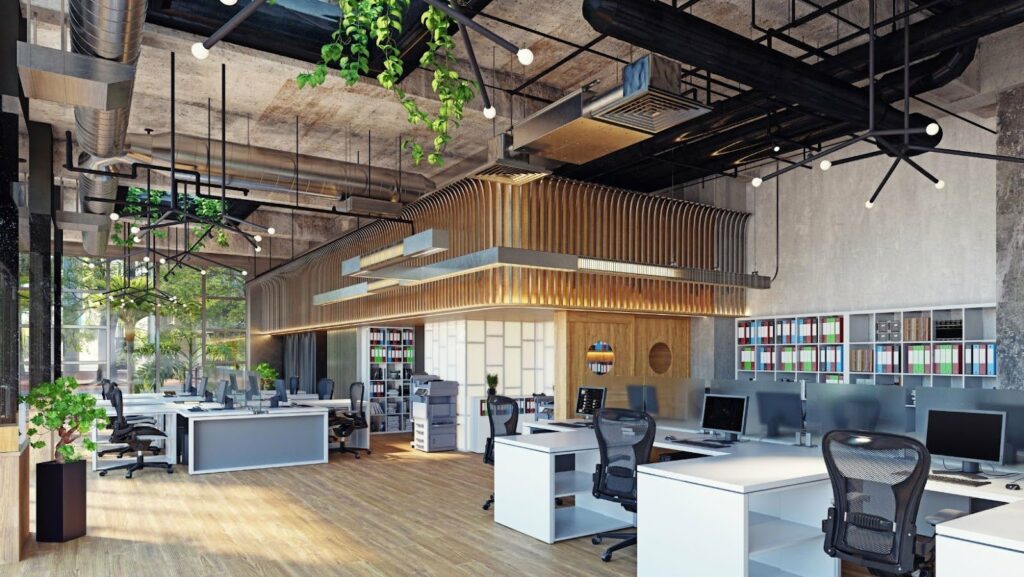Boost your productivity through optimized office design and space planning. Every detail of your workspace, from the layout to the lighting, is essential in daily office operations. Studies have shown that strategic office design can boost productivity by up to 20%.
In this guide, you’ll find actionable strategies that address common workplace challenges. This will also transform your office into a space of efficiency and innovation.
Table of Contents
ToggleThe Basics of Office Space Planning
Your office design and space planning starts with understanding the principles of smart design. Your task is more than arranging desks and chairs. It involves creating a flow that maximizes space and enhances productivity. Key elements include zoning areas for various activities to ensure ease of movement. This will also help you make use of every square foot to its fullest potential.
How to Conduct a Need Analysis
A thorough analysis will enable you to create a workspace that maximizes productivity and enhances employee satisfaction. Here are insights and tips on how to conduct an effective needs analysis:
Gather Data on Team Sizes
The number of people working in each department is crucial for determining the space requirements and the best layout. Consider these factors:
- Current and Future Team Sizes – Account for your current staff numbers while planning for potential growth.
- Space Allocation – Larger teams may need bigger or more flexible workspaces. Meanwhile, smaller teams might benefit from more intimate settings. Consider the interactions between different teams as well to optimize collaboration and accessibility.
Analyze the Nature of Work
The work performed by each team influences the design of their workspace. Different work types may require different environments:

- Creative vs. Analytical Tasks – Creative teams, like marketing and design, may thrive in open, inspirational spaces that foster collaboration. In contrast, teams that perform analytical work, such as accounting or research, might need quieter areas.
- Use of Technology – Departments that rely heavily on technology may need spaces that are optimized for electrical and data access.
Assess Privacy Needs
Privacy is an essential component of office design since it affects productivity and job satisfaction.
- Acoustic Privacy – Consider using soundproofing techniques or materials if your team handles sensitive information or require concentration. Provide sound-masking systems, like white noise machines, or implement designated quiet zones.
- Visual Privacy – Some employees may need shielding from visual distractions. Include frosted glass partitions, adjustable privacy screens, or strategic plant placements. They can provide the necessary barriers without creating a sense of isolation.
- Confidentiality Requirements – Departments dealing with HR, legal, or financial matters may require secure areas that are accessible only to authorized personnel. Evaluate the need for secure entry systems or restricted areas to protect sensitive information.
Use Tools for Effective Analysis
The right tools can streamline the needs analysis process and provide data-driven insights.
- Surveys and Feedback – Distribute surveys to gather feedback on the current office layout and suggestions for improvement. These insights can highlight unseen issues and areas for enhancement.
- Workflow Analysis – Map out the workflows of different teams to identify high-traffic areas, bottlenecks, or underutilized spaces. Workflow analysis helps in creating a layout that supports smooth operations and minimizes disruptions.
- Space Utilization Software – Use software tools that track how different areas in the office are used. This technology can provide valuable data on peak usage times, frequently used paths, and space efficiency.
Modern Office Design Concepts and Layouts
Explore various office layouts such as open plans, hybrid models, and activity-based workspaces.

Each has its merits and challenges, and choosing the right one can affect productivity and employee satisfaction.
Integrating Technology in Office Design
Effective integration of tech solutions, from wireless communication tools to conference technology, is crucial for a functional office.
The Role of Ergonomics in Workspace Design
Ergonomics is vital for maintaining employee health and productivity. An ergonomic design minimizes the risk of injury and boosts comfort, which in turn enhances work output.
Include considerations for desks, chairs, and computer equipment that promote good posture and user comfort.
Aesthetic Elements – Balancing Function and Style
Aesthetics play a critical role in how employees feel about their workspace and, by extension, their work. A visually appealing office can boost morale and reflect the company’s brand values.
Color schemes can enhance the office mood. You should also seek an optimal balance of natural and artificial lighting. Furthermore, consider incorporating decor that inspires creativity and calm.
Sustainable Practices in Office Design
Energy-efficient designs can reduce operational costs while contributing to a healthier planet by minimizing carbon footprints. Include LED lighting, energy-efficient HVAC systems, and smart sensors to cut energy use and costs. Additionally, focus on waste reduction practices, such as e-recycling programs and the use of biodegradable products.
Indoor plants and green walls can improve air quality by removing harmful toxins. They also enhance aesthetic appeal, which can boost employee morale and productivity. Incorporating natural elements in the workplace can reduce stress levels and increase worker satisfaction.
Furthermore, green spaces contribute to thermoregulation in buildings, reducing the need for artificial cooling and heating systems.
Conclusion
A well-planned office is more than a space to work. It is a dynamic environment that adapts to the evolving needs of its users.
Consider the potential of your current office setup. Think about the transformations that could lead to better productivity and employee satisfaction. Reach out to professional office designers who can turn these concepts into reality. You can also start small by re-evaluating your current layout and decor. Is it not time your workspace worked as hard as you do?
